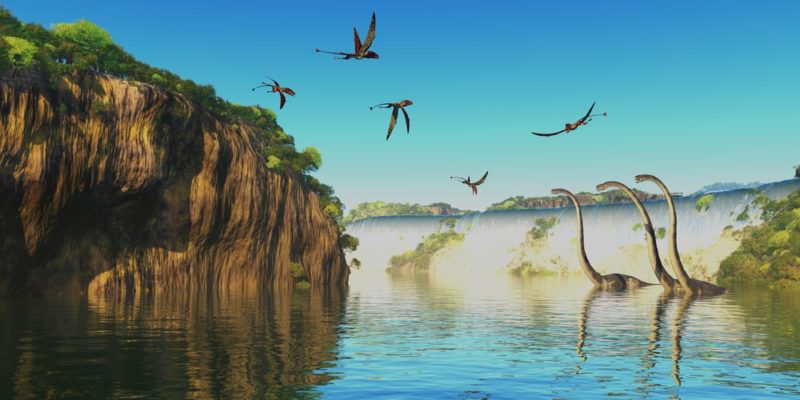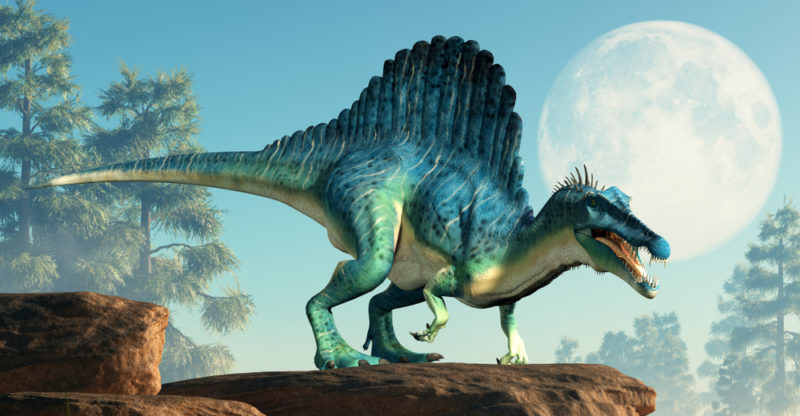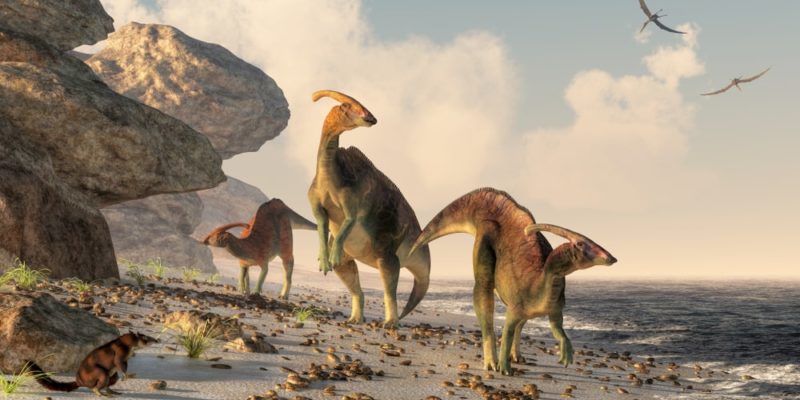We explore the Mesozoic Era, and discuss its characteristics and divisions. In addition, we describe its climate, flora and fauna.

What was the Mesozoic Era?
The Mesozoic Era is one of the three eras that make up the Phanerozoic Eon, along with the Paleozoic (preceding) and Cenozoic (succeeding) eras. It began 248 million years ago and ended 65 million years ago, spanning a total interval of 183 million years.
The Mesozoic is also known as the "age of dinosaurs" due to the fact that life on Earth was dominated by those animals. The era is divided into three periods: Triassic, Jurassic, and Cretaceous, the latter marking the end of the era.
From a geological perspective, the Mesozoic Era witnessed the beginning of the breakup of Pangea, the single supercontinent that existed at the time. Thus, the continents began to move apart, slowly drifting to their current positions.
Climatically, it was a changeable era, alternating periods of lower temperature and humidity with extremely humid and warm ones, which contributed to the formation of vast expanses of forest and jungle.
The term Mesozoic means "middle life" (from the Greek meso, meaning "between", and zoe, meaning "life form", "animal"), as it lies between the "ancient life" (Paleozoic, from the Greek palaio, meaning "old") and the "new life" (Cenozoic, from the Greek kainos, meaning "new").

- See also: Cenozoic Era
Characteristics of the Mesozoic Era
The main characteristics of the Mesozoic Era are:
- It began 248 million years ago and ended 65 million years ago.
- It is divided into three periods: Triassic, Jurassic, and Cretaceous.
- It is known as the "age of the dinosaurs".
- The climate was predominantly warm and humid, with the exception of the Triassic Period, which was drier.
- The breakup of the supercontinent Pangea began during the Jurassic Period.
- The first mammals, insects, and flowering plants appeared during this era.
- It ended with a global mass extinction known as the Cretaceous-Paleogene (K-Pg) extinction event, which resulted in the disappearance of dinosaurs and many other species.
Division of the Mesozoic Era
The Mesozoic Era is divided into three major periods:
- Triassic Period. It began 248 million years ago and ended 206 million years ago. During the Triassic, Earth’s landmass existed as a single supercontinent called Pangea, which eventually broke apart to form all present-day continents. The period saw the rise of the first dinosaurs, mostly bipedal and carnivorous, as well as the earliest mammals, which evolved from reptiles.
- Jurassic Period. It began 206 million years ago and ended 144 million years ago. The Jurassic was marked by the proliferation and dominance of dinosaurs on Earth. During this period, the rifting of Pangea began.
- Cretaceous Period. It began 144 million years ago and ended 65 million years ago. Spanning 79 million years, it is the longest period in the geological history of Earth. During the Cretaceous, dinosaurs continued to evolve, reaching the most complex forms in their evolutionary history. In addition, the first birds rose, and mammals diversified.
Geology of the Mesozoic Era
At the start of the Mesozoic, the continents existed as a single supercontinent called Pangea, which during this era began to split into two massive subcontinents: Laurasia to the north and Gondwana to the south.
This supercontinent was surrounded by two seas: Panthalassa, which occupied a vast portion of the planet, and the Tethys Sea, located within Pangea’s interior. When Africa and Europe separated from the Americas, the Atlantic Ocean began to form. Likewise, when Africa separated from Asia, the Indian Ocean formed.
Towards the end of the era temperatures were high, leading to a rise in sea level and, which in turn, caused large portions of continental landmasses to become submerged underwater. This, along with continental drift, contributed to the creation of inland seas, which increased humidity in most of the planet.
Climate of the Mesozoic Era

The climate during the Mesozoic Era shifted considerably. In the early Mesozoic, during the Triassic Period, it was warm and dry, a legacy of the preceding era. This climate allowed the formation of deserts and the predominance of arid climates within Pangea’s interior, with vast expanses far from the moisture of the oceans.
During the Jurassic Period, the climate became more humid, with high temperatures and abundant rainfall. With the gradual breakup of Pangea into continents, the deserts within the interior of the supercontinent became more humid, giving rise to tropical and subtropical forests across most of the planet.
Towards the end of the Mesozoic Era, in the Cretaceous Period, the climate remained humid and temperatures rose in comparison with the Jurassic. The concentrations of greenhouse gases, particularly carbon dioxide, were higher during this period than in earlier times of the era. This may have contributed to the rise in global temperatures.
Fauna of the Mesozoic Era

As the Mesozoic began in the wake of the Permian-Triassic mass extinction, conditions were ripe for the emergence of new species, both animal and plant. This ecological niche, devoid of large predators, was taken by reptiles and later by dinosaurs.
Thus, dinosaurs were the dominant life-form throughout the Mesozoic, on land, air, and sea. Some were massive, slow-moving herbivores, while others were small and fast carnivorous predators.
Likewise, there is evidence of the existence of a great diversity of insects and arachnids, which, due to high levels of oxygen in the atmosphere, grew to be much larger than those we know today.
The end of the era saw the proliferation of mammals, though to a much lesser extent than dinosaurs. A large number of birds and flowering plants arose, giving rise to pollinating insects such as bees.
The Mesozoic era ended with a mass extinction known as the Cretaceous-Paleogene (K-Pg) extinction event, during which all land and sea dinosaurs as well as many other species suddenly disappeared. The most widely accepted hypothesis suggests that it was due to the impact of a meteorite in Yucatán, Mexico.
Flora of the Mesozoic Era
During the early part of the Triassic Period, the climate was warm and dry. The flora was dominated by ferns and palms in the warm regions of Gondwana, and by coniferous plants in the more temperate zones of Laurasia.
Rising humidity levels during the Jurassic Period enabled vegetation to spread across the new subcontinents. Deserts became wetter, and forests and jungles abundant.
A significant evolutionary event in plant life occurred towards the end of the Cretaceous Period: the emergence of angiosperms, that is, flowering plants, as a new botanical form.
The role of insects was key in the pollination process. Since the first bee originated during the Mesozoic Era in the Cretaceous Period, it is believed that insects and angiosperms evolved together.
Explore next:
References
- Ferrando Castro, M. (2018). ¿Qué fue la extinción masiva del Triásico-Jurásico?. RedHistoria. https://redhistoria.com/
- Fisher, A. (2022). Así fue el período Cretácico: la era en la que el cambio climático acabó con el dominio de los dinosaurios. National Geographic en Español. https://www.ngenespanol.com/
- Mundo Prehistórico. (s.f.). Fauna Jurásico. Los dinosaurios. https://www.mundoprehistorico.com/
- Museo de La Plata. (s.f.). La era Mesozoica: edad de los reptiles. Facultad de Ciencias Naturales y Museo, Universidad Nacional de La Plata. https://www.museo.fcnym.unlp.edu.ar/
- Pérez López, A. (2022). Triásico. Departamento de Estratigrafía y Paleontología, Universidad de Granada. https://wpd.ugr.es/
- Tarbuck, E. y Lutgens, F. (2005). Ciencias de la Tierra. Una introducción a la geología física. Pearson Educación.
Was this information useful to you?
Yes NoThank you for visiting us :)